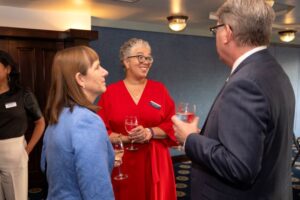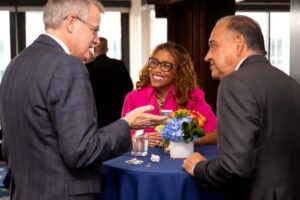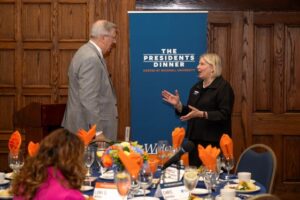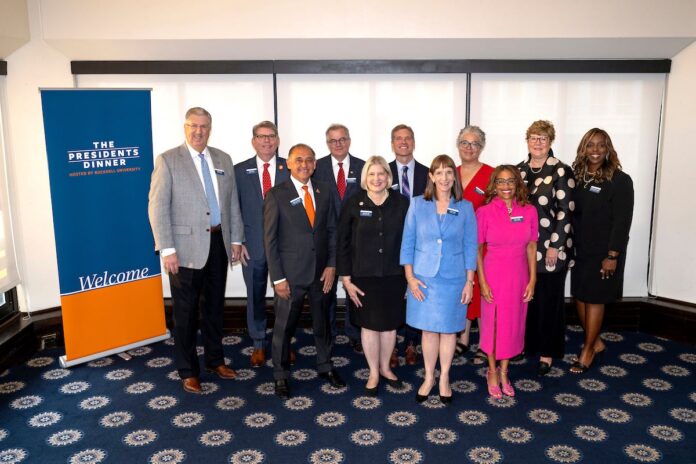Some of us were still working on our salad when the on-record conversation at The Presidents Dinner in Washington, D.C., last Thursday turned to free speech. One reporter asked the 11 private college presidents in attendance if, to shield their institutions from lawsuits and Title XI complaints, they’d be willing to commit to the full scope of First Amendment protections, like public colleges are obligated to do.
The question hung in the air for a long 30 seconds. By the time Amherst College President Michael Elliott raised his hand, the topic of free speech and its appropriate constraints on campuses lasted through dessert.
The main issue: How can liberal arts colleges balance freedom of expression while protecting students from harassment?
“That is not an easy thing. Anyone who pretends it is, is kidding themselves,” Elliott said. “We are under real pressure from the Department of Education and the Office of Civil Rights to ensure our campuses are welcoming for our students. We cannot hide behind the First Amendment; to only use that principle would not only be foolish but put us at legal risk.”
Bucknell University President John Bravman’s consultation with legal scholars has led him to believe no formula balances these competing values. Defining the limit on free speech today becomes even more difficult considering how easily social media can share and oftentimes inflame the severity of campus protests. Roughly one in 10 students surveyed by the Foundation for Individual Rights and Expression this summer stated they participated in a protest.
“It’s a misnomer that higher education is full of these ‘woke’ campuses that are run amok,” added Carmen Ambar, president of Oberlin College & Conservatory.
Pomona College President Gabrielle Starr believes institutions can circumvent most of their legal troubles surrounding free speech and harassment by promoting civil dialogue initiatives on their campuses. “People don’t know how to listen, and we’re incredibly bad at managing dissent and we don’t understand how to cooperate.”

Several leaders laid out some of their most recent initiatives to promote stronger civil dialogue. Agnes Scott College’s Courageous Conversations brings students, faculty and staff together to be vulnerable in small-group conversations, and Oberlin’s Sustained Dialogue Program trains students to facilitate conversations on difficult topics. The latter, Ambar believes, cultivates students to defend their opinions while maintaining openness to other viewpoints. “You have to practice to listen to other people.”
The University Business Podcast: How to turn an academic evolution into a revolution
Helping students become well-versed in the art of civil dialogue makes it easier for classrooms filled with 18- and 19-year-old students to do and say “foolish things,” said Furman University President Elizabeth Davis. “We give people grace, we know sometimes things may be said that aren’t quite right. That’s part of the learning process.”
“We don’t want to set this up as a legal matter,” Davidson College President Doug Hicks added. “People need space to try out ideas in an environment that’s accepting and tolerant of all voices.”
He conceded that larger institutions may have a more difficult time cultivating belonging than colleges enrolling less than 5,000 students—which made up every school at the dinner table. Moreover, a report from FIRE found that 42% of students nationwide believe that it is only “somewhat” clear that their administration protects free speech, while 24% think it is “not at all” or “not very” clear.

And despite their lofty aspirations, several presidents doubted whether legislatures and the public had enough faith in smaller liberal arts colleges to adequately develop the young minds of America beyond job preparation.
“We’ve lost the narrative on [our mission] to prepare students to become active citizens in our democracy,” said DePauw University President Lori White. “Four-year residential universities are one of the only places left in America where we bring folks together of different experiences and challenge them to wrestle with the messiness of living in a diverse community.”
Maintaining diversity on campus
Presidents also traded their viewpoints on recent DEI rollbacks and the end of affirmative action. Amherst College experienced an eight percentage-point decrease in Black enrollment this fall. President Steve Thorsett, on the other hand, said that Willamette University not only maintained its diversity but boasts the most racially, ethnically and socio-economically mixed group in the Northwest among peer institutions.
While consensus on affirmative action’s end may be difficult after one admissions cycle, Bucknell’s Bravman isn’t excited to see where the number will go following years-long studies on institutions’ diverse populations. “It’s changing our populations. The outcome of that is going to be varied, significant and negative.”
State lawmakers championing their efforts to end legacy admissions as a means to move the needle on diversity is “so sadly wrong,” said Pomona’s Starr.

Rather, underfunded school systems, a lack of pre-K12 pipelines and nominal Pell Grant award increases are examples of larger legislative forces perpetuating education equity.
“It’s a tiny difference compared to the massive difference financial aid makes in determining whether a student gets into most institutions,” said Carleton College President Alison Byerly. “We’re all focused on making it as affordable as possible for our students to come to college.”
What else keeps presidents up at night?
Only so much could be covered by the time the cocktail bar opened up again. Here are three other issues that sparked passionate yet brief conversations.
- AI stumps Bucknell’s Bravman on how to regulate student usage due to the speed of its development.
- Policy changes: Kalamazoo College President Jorge Gonzalez is wrestling with creating policies that comply with continuously changing federal regulations. U.S. President Joe Biden’s Title IX changes, for one, remain in limbo.
- Divestment: While pro-Palestinian activists nationwide demand institutions divest from corporations promulgating warfare, Oberlin’s Ambar likens the complexity of tinkering with an endowment’s investment portfolio to “trying to take the cheese out of a lasagna.” However, she understands the need to help students feel like more than bystanders.




